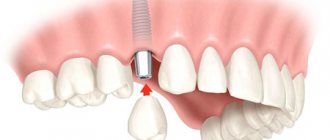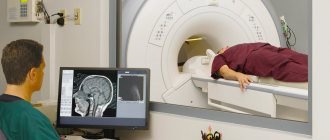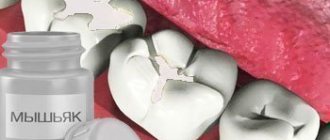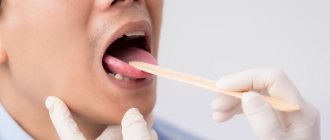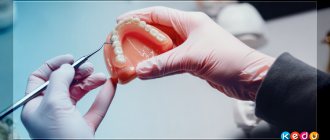What is gnathology?
The human dental system consists of the jaw bones, muscles, ligaments, teeth, tongue, temporomandibular joint (TMJ) and nerves. The work of all these organs, as well as their interaction with each other and with the body as a whole, is studied by gnathology. The proper functioning of our chewing system depends on the condition of the spine, on posture, on how a person breathes, and on many bad habits we have acquired. And, conversely, a downward influence is also possible: problems in the temporomandibular joint can result, for example, in pain in the legs.
Restorative dentistry has made amazing strides in recent years. Dentists - orthopedists, orthodontists, and estheticians have learned to literally recreate amazingly beautiful smiles that can change a person’s life. However, if during treatment the doctor does not take into account the myofunctional disorders the patient has, then the result of the work will not bring satisfaction to any of them. It is possible to achieve high aesthetics and improve the functioning of the dentofacial apparatus only if we consider each restored tooth not as a separate unit, but as an integral part of the whole organism.
Gnathology is closely related to such relatively new specialties as osteopathy, kinesiology, as well as neurology and otolaryngology. Dental gnathologists work closely with these specialists.
There is a question: who is a gnathologist and what problems should I contact him with?
Every fifth woman with cancer is faced with cancer of the female reproductive system. The expert shared tips on how to prevent the development of “female cancer” and detect pathology in time.
Svetlana Khokhlova
, MD, PhD, Head of the Oncology Department of Antitumor Drug Therapy, Federal State Budgetary Institution National Medical Research Center of Obstetrics, Gynecology and Perinatology named after.
V.I. Kulakova" Why do tumors of the female reproductive system occur?
What factors can influence the development of the disease? In most cases, tumors of the female reproductive system occur spontaneously. Their development may be a consequence of lifestyle, nutrition, environmental situation in the city and many other factors. During life, all these factors influence the human body, where mutations form and accumulate, which can subsequently provoke the development of cancer.
In terms of genetic predisposition, having inherited BRCA-1 and BRCA-2 mutations significantly increases the risk of developing ovarian and breast cancer. Endometrial cancer can also be caused by the rather rare hereditary Lynch syndrome.
Another common factor is the presence of oncogenic strains of the human papillomavirus, which increase the risk of developing cervical cancer and a number of other tumors. The human papillomavirus is not hereditary and is transmitted primarily through sexual contact.
Research is constantly being conducted to identify the causes of cancer. In particular, various hereditary syndromes and mutations are being studied, as well as their connection with the development of tumor processes. Their detection and study allows us to create screening programs and improve diagnostic methods for both genetic mutations themselves and oncological pathologies and precancerous conditions.
At what age is there the highest risk of developing cancer in the reproductive organs?
The average age of patients with new cases of gynecological cancer is 60-64 years. However, tumor processes associated with hereditary syndromes and mutations, as a rule, occur at an earlier age - approximately 35-40 years.
Please tell us about the alarming symptoms of gynecological cancer. How are such diseases diagnosed and can they be detected at an early stage?
Of the entire group of gynecological oncological diseases, ovarian cancer is the most insidious. The fact is that with ovarian cancer, patients have no complaints in the initial stages. Nonspecific symptoms such as weakness, constipation and general malaise may appear, but they are extremely rarely complained about to the gynecologist.
In most cases, patients with this pathology have complaints when symptoms appear that indicate a widespread process (stages III-IV). Symptoms such as abdominal enlargement and nagging pain may indicate tumor damage.
Cancer of the body and cervix is often diagnosed in the early stages. Since they are external organs, even a small tumor is often accompanied by bleeding. Other symptoms may include excessive discharge, bleeding, and pain in the lower abdomen. As a rule, patients do not ignore such symptoms and immediately consult a doctor, where in some cases the diagnosis is confirmed.
It is worth noting that cervical cancer can be suspected at an early stage, even during an examination by a gynecologist.
Today, there are certain programs that make it possible to diagnose tumors of the female reproductive system in the early stages. The most basic and important procedure is preventive examinations by a gynecologist every six months for all girls over 25 years old. Do not forget about medical examination, which is carried out once every 3 years. For women over 40 years of age, a breast cancer screening program has also been developed, which includes mammography.
The above programs apply to all women, including those who do not have any complaints or genetic predisposition. Any disturbing changes should be discussed with a gynecologist, especially if they have been bothering you for a long time. In this case, the doctor will conduct an examination and try to find out the cause.
If the patient suspects a formation in the ovary, for example, a cyst, the doctor will recommend testing for the ovarian cancer marker CA-125. If there is a genetic predisposition, the gynecologist must create an individual screening program. Today, screening and examination measures have already been developed, but, unfortunately, many women neglect this and seek help when they already have quite serious symptoms.
Please tell us about preventive measures
A number of preventive measures have been identified based on large population studies. There is a proven connection between the absence of childbirth and a high risk of developing breast and ovarian cancer. Increasing the number of births and lactation have a beneficial effect on reducing the risk of developing these diseases.
Lifestyle adjustments and a balanced diet have a positive effect on both risk reduction and overall well-being. It has been proven that obesity, which is also often associated with type 2 diabetes, increases the risk of gynecological cancer.
Oncogynecological diseases are associated with hormonal imbalance, inflammatory and hypertrophic processes. Often, endometrial hyperplasia, caused by hormonal imbalance, degenerates into endometrial cancer. Precancerous pathologies, for example, intraepithelial formation of the cervix, are referred to as so-called precancers. Prevention of all inflammatory, hormonal and precancerous diseases and keeping your body in good shape serves as good prevention for many diseases, including cancer pathologies.
Vaccination against human papillomavirus is approved and recommended by all governments as a preventive measure, as it helps reduce the risk of precancerous and hyperplastic diseases resulting from HPV infection. As noted earlier, oncogenic strains of the human papillomavirus increase the risk of developing cancer of the cervix, oropharynx, and anal canal. Research is also being conducted that can prove or disprove the effect of this virus on tumor processes in other locations.
It has long been believed that hormone replacement therapy (HRT) increases the risk of developing a number of gynecological cancers. This was due to the fact that HRT previously consisted of estrogens, long-term use of which can indeed provoke the development of tumor processes. But combined oral contraceptives with estrogens and progestins have proven effective in reducing the risk of ovarian cancer.
For women with confirmed inherited BRCA-1 and BRCA-2 mutations, there are separate screening programs and certain preventive measures, such as mastectomy and removal of the fallopian tubes and ovaries (from a certain age). Carrying out these preventative surgeries reduces the risk of developing breast and ovarian cancer by more than 80%.
Do you think it makes sense to vaccinate girls against HPV, and how much will it reduce the risks? Should everyone be vaccinated or only the risk group? How do you know if you are at risk?
In this case, the risk group does not matter for vaccination. Vaccination against HPV is recommended for both girls and boys during adolescence. The human papillomavirus is responsible for a number of cancers that also affect men.
Each country has different vaccination dates; in Russia it is customary to get vaccinated against HPV from the age of 9. Maximum effectiveness is observed when vaccinated before the first sexual contact, since the human papillomavirus is transmitted primarily through sexual contact. Vaccination is also possible at a later age; this should be discussed with a specialist.
What misconceptions have you encountered among patients about these diseases?
- There is an opinion that eating meat increases the risk of developing breast cancer. However, today doctors are still convinced that meat can be part of a healthy diet, as it serves as a source of protein, B vitamins and minerals. Of course, you shouldn’t overuse it either.
- There is also a common misconception that the HPV vaccine can cause infertility. To date, there is no convincing evidence or any publications confirming this point of view.
- Another myth is related to the effect of in vitro fertilization (IVF) on increasing the risk of developing cancer, but all meta-analyses and studies examining this issue indicate the opposite. In this case, one must also understand that artificial insemination is most often performed on patients whose reproductive function is already impaired.
Please tell us how patients with cancer of the reproductive organs are treated?
What treatment options are currently available to Russian patients? Depending on the course of the disease, patients may be prescribed different treatment methods: surgery, radiation or drug therapy. In some cases, it is possible to use combination therapy - a combination of several types of treatment.
Medicine does not stand still; treatment methods and drugs are constantly being improved. When I began my career as an oncologist in 1996, patients were primarily treated with chemotherapy. Now, due to the high toxicity of chemotherapy drugs, they are gradually trying to move towards methods with better tolerability. The main efforts are aimed at the development of modern drug therapy, which includes targeted and immuno-oncology drugs. In addition to the convenience of their administration, the possibility of adjusting treatment and lower toxicity, modern drugs also have higher effectiveness compared to chemotherapy. Targeted drugs are capable of targeting a tumor where there are certain mutations and expressions in genes. Immuno-oncological drugs, in turn, are able to reactivate the human immune system, allowing it to independently detect and destroy a tumor cell, since in a number of oncological diseases, in particular gynecological oncology, the immune system ceases to perceive the cancer cell as a threat, allowing it to grow and spread.
My patients with 15-20 years of illness experience rejoice at every new development and hope that it will at least slightly extend their lives. This is what happens. New therapeutic solutions are developing rapidly and, most importantly, they have a tremendous impact on the survival of our patients. This always makes both patients and doctors very happy and motivated.
What is the temporomandibular joint, and how is it related to the functioning of our dental system?
The temporomandibular joint, or TMJ for short, is a two-part joint that attaches the lower jaw to the bones of the skull. It is responsible for the proper functioning of the lower jaw, for the processes of opening and closing the mouth and chewing food. Any changes in the joint lead to toothaches and discomfort in the neck and back of the head, as well as clicking in the joint, tinnitus and other symptoms.
Incorrect functioning of the TMJ is associated not only with bad childhood habits, but also with numerous unnerving situations. Due to frequent stress, the masticatory muscles are in constant tension. As a result, teeth can wear out or become loose, the articular head is displaced, the neurovascular bundle is pinched, severe pain occurs, and the person cannot chew food normally. We are so immersed in our problems that we don’t even notice how we constantly clench our teeth and learn about this bad habit only in a specialist’s office.
Why does TMJ dysfunction develop?
The reasons for the development of dysfunction can be very different - from the position of the teeth to pathologies that have nothing to do with dentistry. Pathological changes in the mandibular joint can be provoked by:
- variable changes in the psyche (neurosis, constant stress);
- problems with the autonomic nervous system (heart rate irregularities, blood pressure surges);
- parafunction of masticatory muscles;
- injuries in the TMJ area;
- episodic microtrauma of the joint caused by irrational or poor-quality prosthetics;
- traumatic occlusion;
- incorrect dental treatment (fillings that are too high);
The cause of TMJ dysfunction can also be untimely restoration of lost teeth, except for “eights”.
How can you understand that pain and spasms in the jaw area are associated specifically with the TMJ?
Most often, with disorders of the TMJ, people go to the dentist with complaints of toothache. And only an experienced dentist can determine that this patient needs to undergo a full examination by a gnathologist.
When diagnosing disorders in the functioning of the TMJ and the dental system as a whole, a number of devices are used that evaluate the functioning of the muscles and joints, determine exactly how the teeth close, and help relieve spasms. The patient must be examined using all of the above equipment in order to identify and eliminate the cause of anomalies that have arisen in this area.
Differential diagnosis
Since the symptoms described above are similar to the manifestations of pathologies that are in no way related to gnathology, the doctor additionally conducts a differential diagnosis. A patient who comes to see a gnathologist may develop the following serious pathologies:
- myocardial infarction (pain radiates to the neck, lower jaw and shoulders);
- otitis media of unknown origin (severe jaw pain and hearing loss);
- cerebral circulatory disorders (dizziness, flashing “flies” before the eyes, nausea);
- thoracic and cervical osteochondrosis (pain is localized in the same areas);
- pinching of the facial nerve (unilateral hypertonicity of the facial muscles and tissue swelling);
- complications of pathologies of teeth and gums (inflammation and limitation of mobility of the lower jaw).
To exclude an error in diagnosis, the gnathologist carefully examines the patient’s medical history and identifies possible relationships between a person’s chronic diseases and the symptoms that appear.
What techniques do you use to eliminate TMJ dysfunction?
In addition to special equipment, mouth guards and trainers help relieve tension and restore muscle function. That is why specialists prescribe them to patients before or after the installation of orthopedic structures. In addition, trainers and mouthguards also allow you to optimize and shorten the process of orthodontic treatment, especially when it comes to children. Previously, it was believed that a child with a narrow jaw could not avoid crowded teeth. Modern experts have refuted this statement and proved that jaws can “adjust” to any size of teeth, provided that nothing interferes with their growth. However, improper functioning of the muscles can stop the development of the jaws, and they will have to be expanded with the help of braces or complex treatment. A gnathologist helps you tone your muscles in a timely manner and avoid the appearance of serious curvatures. And this applies not only to children, but also to adults, with the only difference being that for the latter, the process of achieving the desired result will take a little longer.
Another way to restore proper muscle function is myogymnastics, a special program that stimulates the formation of a correct bite and its correction, preventing relapses after orthodontic treatment. The specialist will prescribe which exercises you will perform.
Basic diagnostic methods
Since a gnathologist works with patients who have mixed pathology affecting several body systems, there are more than enough diagnostic methods in gnathology. To make an accurate diagnosis, gnathologists use:
- X-ray. Allows you to determine the presence of organic changes in the structures of the dentofacial apparatus;
- MRI, CT. More informative methods allow one to assess the condition of tissues and the presence of even minor pathological changes in them.
- Orthopantomography. Used for a comprehensive assessment of the condition of the upper and lower jaw, the presence of changes in bone tissue.
- Dopplerography. To study the condition of blood vessels and diagnose disturbances in the blood supply to the structures of the dental system.
- Electromyography. Allows you to evaluate the function of the muscular system.
Also, when making a diagnosis, consultations with related specialists may be prescribed. The patient is examined by a neurologist, vertebrologist, and if necessary, a consultation with a maxillofacial surgeon is scheduled (in the presence of injuries or developmental anomalies). Also, in some cases, problems with the dental system can be psychological in nature and be provoked by chronic stress, which is accompanied by prolonged spasm of various muscle groups.
Should all dentists have knowledge of gnathology?
If you are seeing a qualified doctor, you do not have to consult a gnathologist before going to see him. Gnathology is the science of the coordinated work of the dental system, so every specialist working in a dental clinic has an idea about it. The doctor applies knowledge in the field of gnathology even when installing a filling. He doesn’t just “cover up” the carious lesion, but restores the affected area with the help of special materials, which he gives a certain shape in accordance with the bite.
In what cases may you need a doctor's help?
Despite the fact that a gnathologist is a rather rare specialty, this specialist can help in solving many medical problems. For the proper functioning of the dental system, the following factors are necessary:
- regular oral hygiene;
- proper nutritional culture;
- absence of bad habits;
- absence of injuries to the facial part of the skull;
- no problems with posture;
- absence or timely treatment of chronic inflammatory or infectious diseases of the oral cavity;
- properly performed dental prosthetics;
- timely correction of bite;
- absence of pathologies of the central and peripheral nervous system and others.
If the patient has deviations in at least one of the above factors, then the risk of dysfunction of the dentofacial apparatus is quite high. It is these patients who need consultation with a gnathologist before undergoing implantation, prosthetics or installation of a brace system.
How often should you visit a gnathologist?
Of course, you shouldn’t visit a gnathologist too often: a regular dentist can handle a regular preventive examination, especially if the patient does not have the above symptoms or any other complaints of a similar nature. However, it is still recommended to consult this specialist if you are facing such an important event as installing braces or dentures. In this case, the effect of the manipulations performed will satisfy you as much as possible.
pixabay.com/
What methods are used by a gnathologist during treatment?
In order to correct dental disorders, a gnathologist can resort to various therapeutic and diagnostic methods.
“First of all, this is functional diagnostics - x-rays, photo recording and other similar studies. It allows us to identify structural features of the jaw joints and outline the correct treatment plan,” emphasizes Ksenia Mandrovskaya.
pixabay.com/
For prosthetics or bite correction, a preliminary modeling stage is typical, and both individual teeth and the entire jaw are subject to strict accounting. In addition, the patient can undergo orthodontic treatment using advanced 3D technologies, therapy using stabilizer splints, as well as myogymnastics - a specialized set of exercises to stimulate normal occlusion and prevent possible future complications.
